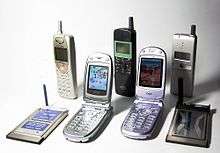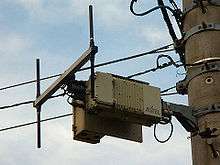Personal Handy-phone System
The Personal Handy-phone System (PHS), also marketed as the Personal Access System (PAS) and commercially branded as Xiaolingtong (Chinese: 小灵通) in Mainland China, is a mobile network system operating in the 1880–1930 MHz frequency band, used mainly in Japan, China, Taiwan, and some other Asian countries and regions.
Outline
Technology

PHS is essentially a cordless telephone like DECT, with the capability to handover from one cell to another. PHS cells are small, with transmission power of base station a maximum of 500 mW and range typically measures in tens or at most hundreds of metres (some can range up to about 2 kilometres in line-of-sight), contrary to the multi-kilometre ranges of CDMA and GSM. This makes PHS suitable for dense urban areas, but impractical for rural areas, and the small cell size also makes it difficult if not impossible to make calls from rapidly moving vehicles.
PHS uses TDMA/TDD for its radio channel access method, and 32 kbit/s ADPCM for its voice codec. Modern PHS phone can also support many value-added services such as high speed wireless data/Internet connection (64 kbit/s and higher), WWW access, e-mailing, and text messaging.
PHS technology is also a popular option for providing a wireless local loop, where it is used for bridging the "last mile" gap between the POTS network and the subscriber's home. It was developed under the concept of providing a wireless front-end of an ISDN network. Thus a base station of PHS is compatible with ISDN and is often connected directly to ISDN telephone exchange equipment e.g. a digital switch.
In spite of its low-cost base station, micro-cellular system and "Dynamic Cell Assignment" system, PHS offers higher number-of-digits frequency use efficiency with lower cost (throughput per area basis), compared with typical 3G cellular telephone systems. It enables the flat-rate wireless service like AIR-EDGE throughout Japan.
The speed of AIR-EDGE data connection is accelerated by combining lines, each of which basically is 32 kbit/s. AIR-EDGE 1× or first version introduced in 2001 provide only 32 kbit/s service. In 2002, 128 kbit/s service (AIR-EDGE 4×) started. In 2005, 256 kbit/s (AIR-EDGE 8×) service started.
In 2006, the speed of each line was also up-graded to 1.6 times with the introduction of "W-OAM" technology. The speed of AIR-EDGE 8× is up to 402 kbit/s with the latest "W-OAM" capable instrument.
In April 2007, "W-OAM typeG" was introduced allowing data speeds of 512 kbit/s for AIR-EDGE 8x users. Furthermore, the "W-OAM typeG" AIR-EDGE 8× service is planned to be upgraded to a maximum throughput of 800 kbit/s, when the upgrading for access points (mainly switching lines from ISDN to fibre optic) in its system are completed. And it may exceed the speeds of popular W-CDMA 3G service like NTT DoCoMo's FOMA in Japan.
Implementation

Originally developed by NTT Laboratory in Japan in 1989 and far simpler to implement and deploy than competing systems like PDC or GSM, the commercial services has been started by three PHS operators (NTT-Personal, DDI-Pocket, and ASTEL) in Japan in 1995 forming the PIAF (PHS Internet Access Forum). However, the service has been pejoratively dubbed as the "poor man's cellular", due to its limited range and roaming abilities. Market share in Japan has been declining and NTT DoCoMo, which has absorbed NTT Personal, and ASTEL is going to terminate the PHS service. Some of other countries have already terminated offering PHS services and migrated to GSM.
Wireless local loop (WLL) systems based on PHS technology are in use in some of the above-mentioned countries. In recent years, WILLCOM, formerly DDI-Pocket, is introducing flat-rate wireless network and flat-rate calling in Japan, which has reversed the local fate of PHS up to an extent. In China, there was seen an explosive expansion of subscribers until around 2005, but it has been calming down in 2006. In Chile, Telefónica del Sur on March 2006 launched a PHS-based telephony service in some cities of the southern part of the country. In Brazil, Suporte Tecnologia has a PHS-based telephony service in Betim, state of Minas Gerais, and Transit Telecom has announced a rollout of a PHS network in 2007.
China Telecom operates a PAS system in China, even though technically it was not regarded as allowed to provide mobile services, because of some particularities of the Chinese governance. China Netcom, the other fixed-line operator in China, also provides Xiaolingtong service. The system was a runaway hit, with over 90 million subscribers signed up as of 2007. The largest vendors of the system are UTStarcom and ZTE. However, low priced mobile phones are rapidly replacing PHS. The Ministry of Industry and Information Technology of the People's Republic of China issued notices on 13 February 2009 that both registration of new users and expansion of the network were to be discontinued with the service to be ended by the end of 2011.[1]
A PHS global roaming service is available between Japan (WILLCOM), Taiwan, and Thailand.
Commercial deployments
This is a list of commercial PHS deployments around the world:[2]
| Country | Operator | ƒ (MHz) | Launch date | End of service | Notes |
|---|---|---|---|---|---|
| |
Transit Telecom | 1910 - 1920 | 2008 (?) | [3][4][5] | |
| |
Telsur | 1910 - 1930 | Mar 2006 | [6][7] Available in Temuco, Valdivia, La Unión, Río Bueno, Osorno, Llanquihue, Puerto Varas and Puerto Montt, Chiloé, Chacabuco, Puerto Aysén and Coyhaique. | |
| |
(?) | (?) | 2002 | (?) | |
| |
(?) | 1895 - 1906,1 (?) | 1997 | May 2016 | [8][9][10] |
| |
Softbank (Y!mobile) |
1884,65 - 1919,45 | Jul 1995 | [11][12][13][14][15][16][17][18][19][20] Willcom merged with eAccess to Y!mobile in 2014. Operated by Carlyle (Willcom) (2004 - 2010). Operated by KDDI (DDI Pocket) (1995 - 2004). 070 prefix under the Japanese telephone numbering plan. | |
| |
TOT | 1895 - 1918,1 | 1999 | [21] Available in Bangkok. Operated under the name "Personal Cordless Telephone (PCT)" | |
| |
(?) | 1895 - 1900 (?) | 2003 | (?) | Available in Hanoi and Ho Chi Minh City. Operated under the name "CityPhone". |
Defunct networks
| Country | Operator | ƒ (MHz) | Launch date | End of service | Notes |
|---|---|---|---|---|---|
| |
China Unicom | 1880 - 1920 | 1998 | Sep 2013 | [22][23] Operated under the name "Xiaolingtong (XLT)" and "Little Smart". |
| |
NTT DoCoMo | 1884,65 - 1919,45 | Jul 1995 | Jan 2008 | [11][24][25][26][27][28] |
| |
Fitel | 1905 - 1915 | May 2001 | Mar 2015 | [29][30][31][32][33][34] |
List of PHS enabled CompactFlash cards
PHS-enabled PCMCIA/CompactFlash cards include:
- TDK DF56CF
- NTT DoCoMo P-in Comp@ct
- NTT DoCoMo P-in m@ster
- NTT DoCoMo P-in memory
- DDI AirH”Card petit [RH2000]
- DDI AirH”Card petit [CFE-02]
- DDI C@rdH”64 petit [CFE-01]
- DDI C@rdH”64 petit [CFE-01/TD]
See also
References
- ↑ MIIT Ceases PHS Registration, Network Expansion.
- ↑ "PHS Guidebook (4th Edition)" (PDF). PHS MoU Group. 2008-09-29. Retrieved 2016-01-29.
- ↑ "Spectrum Management Reform In Developing Countries - Brazil" (PDF). TeleGeography. 2004-02-16. Retrieved 2016-01-29.
- ↑ "Embratel, Transit to offer 1900MHz fixed-wireless services". TeleGeography. 2008-12-04. Retrieved 2016-01-29.
- ↑ "ZTE wins deal to support Transit Telecom's PHS launch". TeleGeography. 2006-11-16. Retrieved 2016-01-29.
- ↑ "Telsur expands network to Coyhaique". TeleGeography. 2007-05-31. Retrieved 2016-01-29.
- ↑ "Telsur Launches PHS over UTStarcom Platform". cellular-news.com. 2006-03-23. Retrieved 2016-01-29.
- ↑ "OFCA begins PHS shut down". TeleGeography. 2013-04-23. Retrieved 2016-01-29.
- ↑ "No more PHS services, concludes OFTA". TeleGeography. 2012-03-02. Retrieved 2016-01-29.
- ↑ "OFTA proposes refarming PHS 1900MHz frequencies for mobile data services". TeleGeography. 2011-11-25. Retrieved 2013-07-05.
- 1 2 "Japan permit Frequency and class of emissions" (PDF). SGS RF Technologies. 2015-10-22. Retrieved 2016-01-29.
- ↑ "MNP service for PHS subscribers in Japan from 1 October". TeleGeography. 2014-09-30. Retrieved 2016-01-29.
- ↑ "eAccess and Willcom merge under the Ymobile banner". TeleGeography. 2014-06-02. Retrieved 2016-01-29.
- ↑ "Softbank to buy 100% of PHS operator Willcom". TeleGeography. 2010-10-15. Retrieved 2016-01-29.
- ↑ "PHS provider Willcom to be split; investors to provide financial aid". TeleGeography. 2010-03-12. Retrieved 2016-01-29.
- ↑ "Softbank named as possible bidder for Carlyle's struggling Willcom unit". TeleGeography. 2009-11-27. Retrieved 2016-01-29.
- ↑ "Carlyle to increase Willcom stake, paper says". TeleGeography. 2009-03-16. Retrieved 2016-01-29.
- ↑ "Adaptix tests Japanese PHS upgrade". TeleGeography. 2006-07-19. Retrieved 2016-01-29.
- ↑ "Willcom to launch high speed PHS". TeleGeography. 2005-06-21. Retrieved 2016-01-29.
- ↑ "Carlyle and Kyocera agree deal for DDI Pocket". TeleGeography. 2004-06-22. Retrieved 2016-01-29.
- ↑ "PHS MoU Group News - Issue 11" (PDF). PHS MoU Group. 1997-08-01. Retrieved 2016-01-29.
- ↑ "Unicom to shut down PHS service". TeleGeography. 2013-07-25. Retrieved 2016-01-29.
- ↑ "PHS networks to make way for TD-SCDMA". TeleGeography. 2009-02-04. Retrieved 2016-01-29.
- ↑ "DoCoMo to exit PHS following drop in subscribers". TeleGeography. 2008-01-07. Retrieved 2016-01-29.
- ↑ "DoCoMo to shut down PHS services next year". TeleGeography. 2007-04-30. Retrieved 2016-01-29.
- ↑ "DoCoMo to unveil HSDPA handsets; shut down PHS network in 2007". TeleGeography. 2006-02-01. Retrieved 2016-01-29.
- ↑ "No more PHS for DoCoMo". TeleGeography. 2005-02-18. Retrieved 2016-01-29.
- ↑ "DoCoMo to scale back PHS operations and focus on 3G". TeleGeography. 2003-09-12. Retrieved 2016-01-29.
- ↑ "Spectrum Planning Progress in Taiwan" (PDF). National Communications Commission (NCC). 2014-10-30. Retrieved 2016-02-03.
- ↑ "Fitel numbers to be reassigned to existing operators". TeleGeography. 2015-05-05. Retrieved 2016-01-29.
- ↑ "Bankrupt Fitel facing licence cancellation as NCC outlines plans to reassign numbers". TeleGeography. 2015-01-05. Retrieved 2016-01-29.
- ↑ "Fitel's PHS coverage shrinks as its switches off base stations to reduce costs". TeleGeography. 2014-04-22. Retrieved 2016-01-29.
- ↑ "Fitel planning to upgrade PHS infrastructure". TeleGeography. 2013-02-11. Retrieved 2016-01-29.
- ↑ "Fitel looking to boost sales of dual technology PHS-GSM handsets". TeleGeography. 2005-11-15. Retrieved 2016-01-29.
External links
| Wikimedia Commons has media related to PHS. |
- PHS MoU Group (PHS MoU was dissolved and absorbed into a new organization "XGP Forum" in 2009.
- Article on Xiaolingtong
- PHS in Taiwan
- Telefonica del Sur in Chile